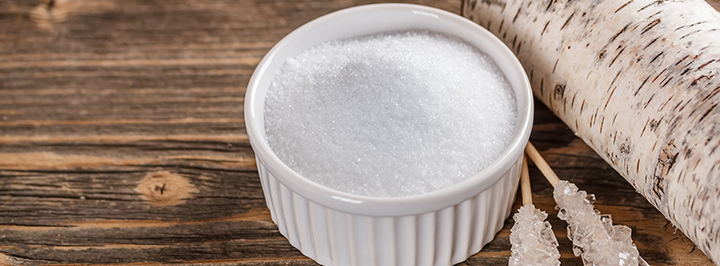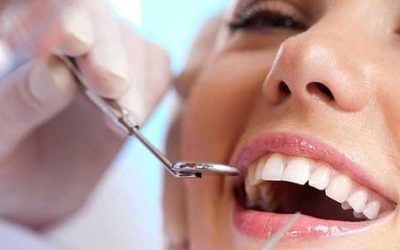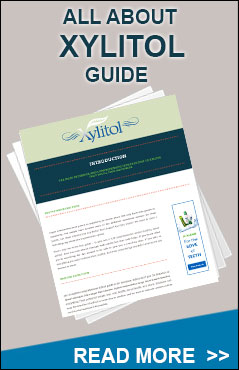The following is information and comments on xylitol and how and why it works so well as a ‘medicine’. Many of the articles referred to below are available at PubMed Central and can be printed from their site–they are hyperlinked in the following. Those referring to books are cited.
My interest in xylitol began with trying to find a way to prevent our granddaughter’s recurring ear infections. Jerry, my wife with a long history teaching problem learners, realized about 40 years ago what Jerry Klein and Charles Bluestone include in their latest update of Otitis Media in Infants and Children – chronic otitis often leads to learning difficulties. After many years of educating such children the issue became critical when a granddaughter was at risk.
I found the work of Matti Uhari and his group in Finland who showed that chewing gum sweetened with xylitol significantly reduced the problem. While many seemed to credit the chewing, Uhari stated that it is due to the action of the xylitol on the bacteria. We thought it prudent to put it where the bacteria live–in the nose.
Uhari’s group did a further study looking at this action. Using a method described by Anderson they showed that xylitol had an effect that inhibited the adherence of nasal pathogens, most powerfully on Strep. pneumoniae. In this and further articles they seem to focus on the ‘antibacterial’ properties of xylitol, but in my conversations with Anders Hakinson while he was at Buffalo, that is not as likely as the anti-adherence effect. Anders was trained in Anderson’s lab and is familiar with the process, but his interest increased when I pointed out to him that in Uhari’s study combining the xylitol with either the pharyngeal cells or the bacteria had a comparable effect on decreasing the adherence. This should not be seen if the action is only antibacterial. Anders has since returned to Sweden, but has committed to pursuing this question when he gets his lab set up.
Other bacteria are likewise effected: C.diff., Staph. aureus, and likely the broadest use is showing its actions in wound care and their problematic biofilms by Randy Wollcott and his group. Randy is a wound care doctor in Lubbock that I talked to about xylitol’s ability to impede bacterial adherence. I only wish the others I have talked to would run with it like he did. With all that we are learning about biofilms, good and bad, xylitol seems to have a decidedly healthy edge. It can help break some loose, as it does with wounds and dental plaque, and it can feed others that are plant based. Most of our human pathogens eat and attach to animal based sugars with six carbon atoms and many of them cannot metabolize plant based sugars with five carbons. But many pathogens do eat it anyway, and those looking at how xylitol disturbs them, show that feeding it to them is not a bad idea either. Feeding our biome plant sugar–xylose related– seems reasonable if we want to help these less pathogenic bacteria.
The adherence of bacteria to their hosts stems from the pioneering work of Nathan Sharon with the mannose lectin of E. coli, the bacteria involved with most female urinary tract infections. Lectins are the binding sites on the bacteria that they use in attaching to a host, and most of them attach to sugar complexes. There are several old and open articles dealing with adherence but the one on cranberry juice and UTI’s is likely one of the more interesting. We describe this experiment in The Boids and the Bees (p. 66-7, edited).
Another study demonstrating the success of this type of prevention was done in Finland using a combination of cranberry and lingonberry juice extracts to prevent urinary infections. In this study grandmother’s advice on drinking cranberry juice to prevent these infections was put to a test–and grandma passed.
There are lots of studies looking at how cranberry juice works, mostly funded by the cranberry juice industry. They show that there are substances in cranberry juice that kill some bacteria and that the nature of the juice acidifies the urine, making it harder for bacteria to live there. But there is more to it than that.
The Finnish study was done on women with recurring urinary infections. They were given the extract twice a day and the time until they got another infection was measured. It was significantly longer with the women on the extract than with women in other branches of the study–they proved grandmother was right.
One of the more interesting and neglected parts of this study, and the part that suggests there is more to cranberry juice than just killing the bacteria or acidifying the urine, comes from the fact that it was designed to last a year, but the supplier of the extract went out of business six months into the study. This is significant because while the women in this treatment group only got six months worth of treatment, there was a benefit that lasted for the whole year! These women were in this study because their infections were chronic–despite killing the bacteria regularly with antibiotics the infections kept coming back. If the extract’s ability to kill bacteria and acidify the urine were the only means of action the women in the group getting the extract would have started getting infected right after the supply ran out–but they didn’t. They received a long-term benefit.
Long-term benefits, when dealing with infections, mean either that the bacteria are gone or that they are not causing a problem. While there may be something in these extracts that make the host defenses stronger previous studies by Sharon and his group, as well as others, argue strongly for this effect being on the bacteria–they either shape up or they ship out.
E. coli and other bacteria that cause urinary infections are able to infect us because there are lots of mannose molecules on the cells lining the urinary tract. The bacteria hold on to these molecules, multiply, and pretty soon the person has an infection. Cranberry and lingonberry extracts do not have very much mannose, but earlier research showed that another sugar, fructose, blocked adherence about a tenth as well as mannose, and these extracts have lots of fructose.
As pointed out these bacteria mostly come from the person’s own gastrointestinal tract–it’s their reservoir. They get into the genitourinary tract by moving across the perineum. Sometimes they are helped by poor hygiene, like wiping the wrong direction. Often they migrate in bath water. So dealing with these bacteria in the GI tract is a reasonable approach and researchers have confirmed that the replacement of pathogens in the GI tract actually happens.
When people use cranberry juice regularly the E. coli in the bowel with mannose lectins hold on to the fructose in the juice and over time are replaced by other strains without the mannose lectin–they ship out. The new bacteria, that don’t hold on to mannose, or fructose, can’t cause urinary infections. The patients received the long-term benefit because their reservoir of bacteria changed to types that could not cause urinary infections. Like the much more benign El Tor strain of cholera you might say these bacteria had been tamed.
Sharon’s colleague Itzhak Ofek is one of the authors of Bacterial Adhesion to Cells and Tissues, a really interesting book on this topic that shows the power of substances like breast milk to protect our infants from so many infections (let alone provide them with much of Mom’s immunity). The proposed competitive inhibition of xylitol for the bacterial lectins comes from the fact that it has a similar atomic structure as the other sugar complexes but is flexible so it can conform to fit the lectin. It may not be what the bacterium wants but it is close enough to confuse the issue. This, in turn, leads to the ideas of Paul Ewald that he explains in The Evolution of Infectious Disease. He argues that when bacteria are threatened they are pushed to adapt defensively toward increased resistance, but when the approach is not a threat but a constraint (as with soap and water, isolation, gown-gloves-and mask) they are pushed to adapt in a more commensal and friendly manner. If they can’t get to another host they are stuck with you, and it is then in their own interest not to kill you. We argue that using agents that decrease bacterial binding fit here as well–they apply the same pressures to adapt in a commensal way–and that such use is likely the best and simplest way to get out of our current problem with antibiotic resistance. (That is the upshot of my article in Medical Hypotheses.) More recently a group in Brazil have given more substance to this issue and the role of xylitol in “bypassing microbial resistance.” Commensal changes have actually been shown in Strep. mutans, the dental bacteria that make acids from ingested sugars that eat through dental enamel to begin a cavity, and long-term benefits shown when xylitol is used at critical periods of dental development, just as the cranberry-lingonberry extract discussed above. Oral xylitol is aimed primarily at these bacteria. LucTrahan, at Laval, showed that exposure to xylitol leads to ‘resistant’ bacteria that learn not to eat the xylitol (which they can’t digest), but at the same time they learn not to make acids. That’s a win-win solution; again, what xylitol essentially says to these bacteria is ‘shape up or ship out’, and they do both. Trahan was also the researcher who showed that both S. mutans and S. pneumoniae share the same genetic inability to digest xylitol. It would be nice to know if that affects their lectins.
The other side of xylitol is how it works osmotically to increase airway surface fluid, which in turn optimizes our mucociliary clearance. Arundel shows a correlation between humidity and upper respiratory conditions and Fisher & Taykel, who make humidifiers for CPAP machines, have an excellent YouTube presentation of the effect of dry air on muco-ciliary function. Most of us today live in comfortable homes with central heating and cooling, but both heating and cooling lower the humidity. Heating air makes it able to hold more water and less able to give it up in the nose. Cooling air removes water from it in the process. In the mid sixties, when the increases in upper respiratory illnesses began half of new homes in the U.S. had central heating. Compounding this problem was massively increased use and availability of cold pills which work to dry up the runny nose. Such an action is counter to what the nose needs to clean itself; it’s like hobbling the defense of your favorite football team. Not a good idea if you want to win the game. See “Why the Increases?” for more.
The benefit of increasing the airway fluid with xylitol has been studied by Joe Zabner, at the Univ of Iowa, who wanted to use xylitol to help kids with CF. His studies were aimed at getting FDA approval and rumor is that he has given up that route. But he showed that xylitol is safe in dogs, in humans with CF, that it is not absorbed nasally, and that it lasts for some time in the airway. Zabner used a 5% iso-osmotic solution. That in the nasal spray we developed is more than double that, which increases the osmotic effect that Zabner documents.
Our experience is that all nasal related conditions–allergies and asthma, as well as ear, sinus and bronchial infections–are far less problematic if the nose is clean. Regular use of xylitol with its anti-adherence and its moistening effects is likely the best way to clean it.
Related Articles
Is Your Dentist Recommending Xylitol? Why Not?
Xylitol is the most effective way of preventing tooth decay we know of.
Does Xylitol Make a Good Sweetener?
Health conscious people recognize that sugar and artificial sweeteners present serious problems for your body. Over the years, artificial sweeteners have been linked to everything from neurological disorders to cancer, and more. While the results of these studies are...
Great Ways to Use Xylitol as a Sugar Substitute
Xylitol sugar substitute options are almost endless. If you’ve never used xylitol, then you are in for a treat, literally! The different ways that you can use xylitol is nothing short of amazing. Let’s take a look at why this natural sweetener deserves a place in any...
Xylitol in the Diabetic Diet
The author this paper, H. Mehnert, is a German diabetologist who helped promote the use of implantable insulin pumps more than 40 years ago. He realized how much of a problem has come from our overuse of foods that contain sugars or, like...
The Benefits of Gum with Xylitol
The health and dental benefits of xylitol are numerous and, in fact, are so impressive that many people are left shocked. What is it about xylitol that makes it so beneficial? Why is xylitol such a perfect ingredient for gum and other dental...
Xylitol Research
Dental Benefits There is no better way to begin addressing this than to look at Kauko Makinen's work. He has been looking at xylitol and tooth decay from the beginning with the Turku sugar studies. Here is what he wrote this week (September 4,...








